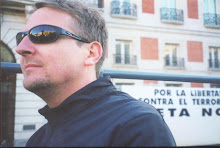 The last pretty big one in Los Angeles was the Northridge earthquake of January 1994. This is a shot of a parking structure at the local University after that temblor. It looks very bad and if you listened to the news without seeing it for yourself it would have seemed liked the whole city was in ruins. Of course, this was very far from the case. Although the magnitude on the Richter scale was moderately high (about 6.8), damage, and I mean the devastating kind, was only scattered around at best. There were two or three collapses of freeway overpasses, a couple of apartment buildings at the epicenter that had their first floors pancake, and maybe four or five other really bad building partial-collapses. The rest of the damage was a lot of cracks and tossed around furniture and dishes - nothing like the thousands and thousands dead you would see in India or South America.
The last pretty big one in Los Angeles was the Northridge earthquake of January 1994. This is a shot of a parking structure at the local University after that temblor. It looks very bad and if you listened to the news without seeing it for yourself it would have seemed liked the whole city was in ruins. Of course, this was very far from the case. Although the magnitude on the Richter scale was moderately high (about 6.8), damage, and I mean the devastating kind, was only scattered around at best. There were two or three collapses of freeway overpasses, a couple of apartment buildings at the epicenter that had their first floors pancake, and maybe four or five other really bad building partial-collapses. The rest of the damage was a lot of cracks and tossed around furniture and dishes - nothing like the thousands and thousands dead you would see in India or South America.The reason for this low damage tally is we are continually trying to build better buildings in California because we know earthquakes are going to come. Another reason is most of our houses and buildings are made out of wood - which is very light and strong, or steel. Not much brick and stone, etc.

But, on the other hand we have Madrid. In Madrid, the older buildings are built with a timber framework that are in-filled with brick or stone to make the walls. These walls are virtual ruble walls with very little value in resisting earthquakes. What's more, each brick is a deadly projectile waiting to clock somebody on the head.
The modern apartment buildings basically have the exact same construction method but they use a (too-thin) framework of steel columns and beams, in-filled with bricks to make the walls and floors. They still are not made to resist earthquakes.
 The reason that brick is not good in an earthquake is that it is very heavy. And the amount of force an earthquake imparts on a building is in proportion to the weight of the building. More weight, more force. Reinforced brick is another matter, but the walls of Madrid apartment buildings are generally not reinforced with steel.
The reason that brick is not good in an earthquake is that it is very heavy. And the amount of force an earthquake imparts on a building is in proportion to the weight of the building. More weight, more force. Reinforced brick is another matter, but the walls of Madrid apartment buildings are generally not reinforced with steel.This shot below is what happens to unreinforced brick buildings in an earthquake:

I will tell you truthfully that I am not crazy to hear about earthquakes in Madrid. The buildings are not built for them. A not-very-big earthquake in Madrid could do A LOT of damage. It is really unfathomable to think how bad a bigger one could be. Fortunately, Madrid is not (supposed to be) earthquake country.



4 comments:
Hey Visitors,
Leave a comment on why you are interested in this post / picture. I get tons of people looking for "L.A. Earthquake 1994" But I don't know why...? Thanks
I visit because I like your blog, I went to high school in So. Cal. I have been through a couple of earthquakes there, I am supposed to work in construction, I've lived in Madrid, I still live in Spain, and every time I see news about earthquakes I literally have a hard time getting to sleep, as I imagine the walls crumbling on top of me, and getting squashed when my building 'pancakes'
As a teenager in Cali. I had a few nightmares after each earthquake, but it was mostly about anarchy after power and water utilities failed. I had enough construction experience by then to know that I could lift an (American made) wall off ground by myself.
It cheap, it's renewable, it's lightweight, it leaves a miniscule carbon footprint compared to concrete and block, and it quick and easy to rebuild or upgrade. The conifers used to create the structure of American style houses can grow just about anywhere, they re-grow very quickly, and they are easy to transport (they float). As a building material, they actual promote single-family structures, as opposed to ceramic and cement, which just continues the status-quo of high prices per sqft, tight spaces, and high population densities. (Gag me with a 40-year Euribor mortgage, why don't you?)
Drawback? In a tornado, one house can become a thousand missiles to destroy the next, and and the next, so on, until the tornado dissipates.
You're right about the tornados and wood buildings. Fortunately, that is not an issue in California.
I am writing a paper on cultural response to earthquake. Have you read Roger Bilham's stuff on the subject?
Post a Comment